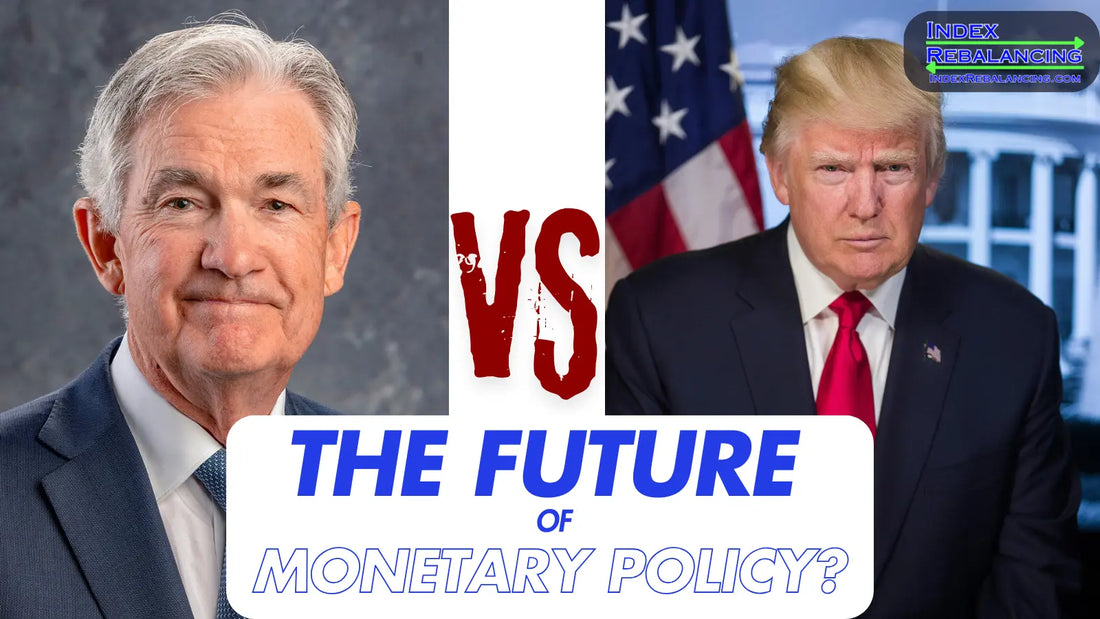
Trump vs. Powell: The Struggle for Control Over U.S. Monetary Policy
Share
The Federal Reserve and its chair, Jerome Powell, have long been at the center of critical economic decision-making in the United States. However, with President-elect Donald Trump expressing strong opinions about having a "say" in the Fed's interest rate policies, the stage is set for a potential clash between political power and the independence of one of the nation's most influential institutions.
This dynamic between Trump’s assertive leadership style and Powell’s commitment to the Fed’s independence could have significant implications for monetary policy, the economy, and investors alike. Let’s explore how this tug-of-war might play out and what it means for markets and portfolios.
The Fed’s Independence Under Scrutiny
Speaking at the New York Times’ DealBook summit, Powell emphasized the importance of the Fed's autonomy in setting interest rates. “We’re supposed to achieve maximum employment and price stability for the benefit of all Americans and keep out of politics completely,” he said, addressing Trump’s campaign assertions that the president should have influence over Fed policy.
Despite Trump’s public criticisms, Powell expressed confidence in Congress’s bipartisan support for the Fed’s statutory independence. “I’m not concerned that there’s some risk that we would lose our statutory independence,” Powell said, highlighting widespread Congressional agreement on the need for the Fed to remain apolitical.
However, Trump’s direct approach to economic issues and his insistence on influencing monetary policy could test these boundaries in the coming years. This struggle could shape how interest rates, inflation, and broader economic policy evolve under Trump’s administration.
The Federal Reserve’s Balancing Act
The Federal Reserve is walking a tightrope as it aims for a “soft landing” in the economy—reducing inflation to its 2% target without triggering a recession. Recent indicators suggest that the Fed is making progress, with inflation moderating and the job market slowing. Powell’s cautious optimism was evident in his remarks, as he noted that the Fed could afford to cut rates carefully given the economy’s unexpected resilience.
“We’re not quite there on inflation, but we’re making progress,” Powell said. “We can afford to be a little more cautious.”
Still, history shows that achieving a soft landing is rare and challenging. Persistent inflation, even modestly above the Fed’s target, could make policymakers reluctant to cut rates too aggressively, potentially clashing with Trump’s preference for rapid rate reductions to stimulate economic growth.
Trump’s Vision: Lower Rates and Faster Growth
During his campaign, Trump emphasized the need for lower interest rates to fuel economic expansion, reduce borrowing costs, and promote investment. His vision aligns with his broader economic goals, including less restrictive regulatory policies and a focus on job creation.
However, the Fed’s caution in cutting rates contrasts with Trump’s more aggressive stance. Powell and other Fed officials, such as Christopher Waller and Mary Daly, have signaled support for gradual rate cuts, contingent on incoming economic data. Waller, for instance, noted that a December rate cut is likely but not guaranteed, depending on inflation and labor market updates.
This divergence in approach raises questions about how Trump and Powell will navigate their differences. While Trump’s presidency is likely to exert political pressure, Powell’s confidence in Congressional support for Fed independence suggests a firm stance against direct interference.
Implications for Markets and Investors
The ongoing tug-of-war between Trump’s economic agenda and Powell’s measured approach to monetary policy could introduce volatility into financial markets. For investors, this dynamic underscores the importance of maintaining a balanced and diversified portfolio to navigate potential uncertainties.
Why Index Rebalancing Matters:
-
Adapt to Market Shifts: Political uncertainty and changes in monetary policy can lead to significant fluctuations in stock and bond markets. Regular rebalancing ensures your portfolio stays aligned with your investment goals, even during periods of volatility.
-
Capture Gains, Manage Risks: With interest rate decisions impacting sectors differently, rebalancing allows you to capture gains from outperforming areas like technology or financials while mitigating risks from underperforming sectors.
-
Stay Diversified: Index funds and ETFs, such as SPY and QQQ, offer exposure to broad market trends. Rebalancing helps ensure your investments remain diversified across industries and asset classes, reducing the impact of sector-specific shocks.
The Road Ahead
As Trump and Powell navigate their respective priorities, the Fed’s independence will remain a critical factor in shaping U.S. monetary policy. While Powell has reiterated his commitment to keeping politics out of the Fed’s decisions, Trump’s assertive style and economic vision could lead to moments of contention.
For investors, staying informed about these developments is crucial. The interplay between political leadership and monetary policy can have far-reaching implications for markets, interest rates, and inflation. By employing a disciplined Index Rebalancing strategy, you can stay prepared for these changes, ensuring your portfolio is optimized for both growth and resilience.
Final Thoughts
The dynamic between Trump and Powell is a story of differing approaches: one prioritizing economic stimulation through aggressive rate cuts, the other championing cautious adjustments to maintain stability. This struggle will undoubtedly shape the economic landscape in the coming years.
For investors, it’s a reminder of the importance of proactive portfolio management. With Index Rebalancing, you can navigate these uncertainties, capture opportunities, and manage risks effectively. Ready to optimize your investments? Explore our Index Rebalancing Guide to stay ahead in an ever-changing market.
